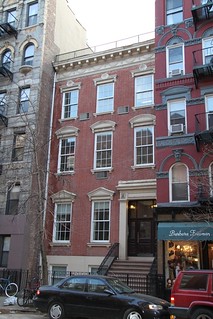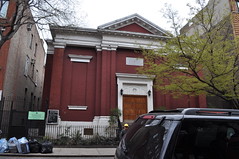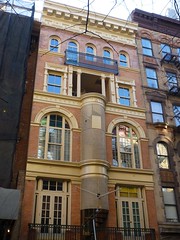Yesterday the executive director of the Greenwich Village Society for Historic Preservation, Andrew Berman, shared the history of six buildings that may soon be part of the proposed East Village-Lower East Side Historic District. Before this afternoon’s critical hearing, he’s delving into the history of six others.
68 East Seventh Street, built in 1835. This row house at 68 East Seventh Street was built speculatively in 1835 by Thomas E. Davis. Sometime in the 1850s or 1860s, the original Greek Revival façade was updated with Italianate details that include the triangular and segmental window pediments and the frieze located below the original cornice. In 1882, the house was sold to the Protestant Episcopal Church Society for Promoting Christianity Among the Jews, which occupied it until 1904, when the house became a Jewish religious school operated by the Machzikei Talmud Torah. It was then subsequently a synagogue. The house was returned to private residential use in 1960.
415 East Sixth Street, Congregation Mezritch Synagogue, converted to a synagogue in 1910 by architect Herman Horenburger. This handsome neo-classical building (which has an even more impressive interior) was one of the Lower East Side’s many “tenement synagogues,” so named because they filled narrow lots sandwiched between tenements and served the poor immigrants who populated the surrounding buildings. Built originally as a dwelling, it was converted to a synagogue in 1910 by German architect and civil engineer Herman Horenburger for the Polish Orthodox Congregation Adas Yisroel Anshe Mezritch (anshe Mezritch means people of Mezritch; Mezritch is a town in Poland well-known for being a center of Jewish learning) which was established in 1888 on the Lower East Side. Congregation Mezritch Synagogue appears to be the sole remaining operating tenement synagogue in the East Village, and thus is an important link to what was once perhaps the most significant Jewish community in America.
323-327 East Sixth Street, Community Synagogue Max D. Raskin Center, formerly the German Evangelical Lutheran Church of St. Matthew, the German Evangelical Church of St. Mark, built in 1847. This Renaissance Revival-style building with a temple front is listed on the National Register of Historic Places. It was built in 1847 as the Evangelical Lutheran Church of St. Matthew for Dutch, German and English Lutherans and ten years later in 1857 became home to the German Evangelical Lutheran Church of St. Mark. The parish is associated with one of the saddest tragedies in New York City. In 1904 the steamship General Slocum caught on fire and then sank with more than 1,000 of the church’s parishioners aboard. As its victims were nearly all women and children, among the major social impacts of the disaster was the migration of the remaining men to outlying neighborhoods. With the fleeing of the German population, a Jewish Lower East Side emerged. In 1940 the church was acquired by the Community Synagogue.
210 East Fifth Street, formerly the Beethoven Hall, built in 1860. Beethoven Hall was one of many social halls in the East Village and Lower East Side in the late 19th and early 20th centuries. As venues for all types of gathering from weddings to union meetings, these halls were an integral part of immigrant community life. This hall hosted a number of important events including the 1880 funeral for six victims of a fire that broke out at a wedding at nearby Turn Hall; the 1890 meeting of the American Bowling Congress which standardized rules for the game and initiated national competitions; a boxing match between featherweight and local hero Joe “The Pride of the Ghetto” Bernstein and Tommy Daly; and the 1915 formation of the Amalgamated Clothing Workers of America. By the 1940s the building became a television studio and then later, Mother’s Sound Stages, a film studio; episodes of “The Honeymooners” are purported to have been filmed there.
62 East Fourth Street, Duo Multicultural Arts Center, formerly Astoria Hall, built in 1889. This building’s history is as distinctive as its façade. It was built in 1889 by Victor Eckstein to house an apartment for his family on the upper two floors, meeting rooms on the second and third floors, and a ground-floor restaurant. The unusual façade has French windows on the second story, arched windows on the third and fifth stories, and columned windows and loggia on the fourth floor. In the early 1900s, the building became a dance hall called Astoria Hall and its ballrooms hosted a variety of events from a performance by John Philip Sousa to early meetings of the International Garment Workers Union. In the 1930s its ballrooms were converted into theaters that were used by a number of Yiddish theater groups and later housed television studios. In the late 1960s and early 1970s it housed Andy Warhol’s porn theater.
59 East Second Street, the Russian Orthodox Cathedral of the Holy Virgin Protection, formerly Olivet Memorial Church, built in 1891 by architect Josiah Cleveland Cady. The Russian Orthodox Cathedral, made of Kentucky limestone, was designed in the gothic style by renowned architect Josiah Cleveland Cady, who would later build such iconic New York City landmarks as the original Metropolitan Opera House, and the West 77th Street frontage of the American Museum of Natural History. The history of the cathedral dates back to 1891 when it was built by the New York Missionary Society as the Olivet Memorial Church to minister to the poor immigrants of the Lower East Side.
In 1943, the Olivet Memorial Church was purchased by the Orthodox Church in America, which was established in 1870. In the aftermath of the Russian Revolution, the Soviet government sued for control of all properties worldwide that had been built using Tsarist funds. Among these properties was St. Nicholas Russian Orthodox Cathedral on East 97th Street, formerly the home of this parish. This parish separated from St. Nicholas and relocated to the Lower East Side by moving into part of St. Augustine’s Chapel on East Houston Street, and then many years later purchasing the Olivet Memorial Church and rededicating it as the Cathedral of the Holy Virgin Protection.









